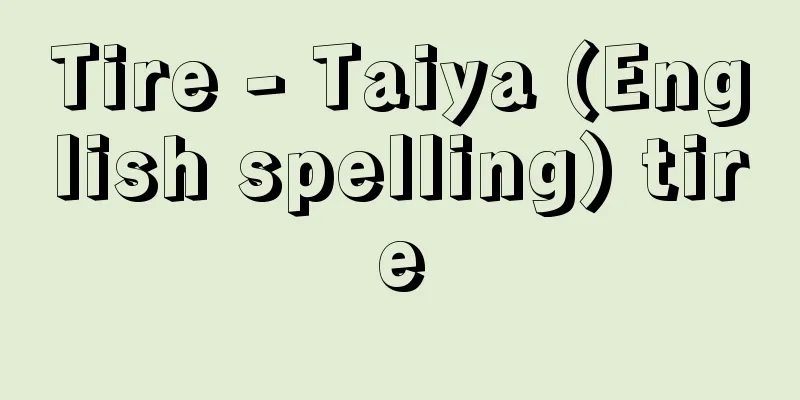Tire - Taiya (English spelling) tire

|
A general term for the part of the wheel of a transport vehicle that travels on land that comes into contact with the road surface and can be replaced. In rail vehicles, tires are steel wheels that come into direct contact with the rails and are replaced by a shrink fit method when worn, as opposed to wheels that are fixed to the axle. However, the term generally refers to pneumatic rubber tires for automobiles, motorcycles, bicycles, etc. Historically, tires made only of rubber without air, and solid tires filled with sponge inside were also used, but these are rarely seen today, so here we will discuss pneumatic tires for automobiles. [Takashima Shizuo] HistoryIn the days of horse-drawn carriages, wheels were made of wood with iron rings attached to the ground, but as carriages were pulled by horses, the wheels only needed to support the weight. However, automobiles run by turning their wheels and steer by turning the wheels, so friction with the road surface was necessary, and new materials were required. The first solid rubber tire was put to practical use in 1867 by the British RW Thompson. Thompson had also patented the pneumatic tire in 1846, but it was not put to practical use, and the developer of the pneumatic tire was the same British company, Dunlop, who reinvented the pneumatic tire in 1888 without knowing about Thompson's patent. Furthermore, when the first full-scale automobile race was held in 1895, Paris-Bordeaux-Paris, it was the French brothers André and Édouard Michelin (1853-1931) and Édouard Michelin (1859-1940) who raced their homemade pneumatic-tyred "Eclair" (a Peugeot body with a Daimler engine) and made a major contribution to the application and popularization of rubber in automobiles. [Takashima Shizuo] structureAn automobile wheel consists of a metal wheel, a rubber bag-like tube that fills with air, and a tire that encases these and comes into contact with the road (however, today there are tubeless tires that create an airtight space between the wheel and tire and do not require a separate tube). The role of the tire is to protect the inner tube, (1) absorb unevenness in the road surface, improve ride comfort, and reduce fatigue in the automobile itself, and (2) improve friction with the road surface to increase driving force, braking force, and steering. A tire consists of three parts: the tread, the carcass, and the bead. [Takashima Shizuo] treadThe tread, which comes into contact with the road surface, is an extremely important part that determines the vehicle's speed performance, such as speed and acceleration, as well as braking force, steering performance, and directional stability. Even for the exact same vehicle, differences in tires can cause large differences in acceleration performance, straight-line stability, cornering speed, and braking distance. For this reason, a rubber material that meets the contradictory requirements of high friction and excellent abrasion resistance is selected. Also, if you place a frying pan on the tires of a truck that has been driven under heavy load on a paved road in midsummer, they will become hot enough to cook a fried egg on, so heat resistance is also necessary. The tread has various anti-slip tread patterns (groove patterns) engraved on it to increase friction and improve driving force, braking force, directional stability, etc. There are three main patterns: (1) Rib: A tire with continuous grooves and ridges in the direction of tire rotation, which allows for smooth rotation and excellent steering and directional stability. It is mainly used on the front wheels of motorcycles. (2) Lug: In contrast to ribs, lugs have intermittent grooves or ridges that run perpendicular to the direction of rotation. They provide excellent traction and traction power, and are also good at crossing rough roads. Examples of lugs are found on tires for jeep-type 4WD off-road vehicles. (3) Block: A combination of both rib and lug patterns, consisting of independent blocks like caramel granules. It is seen in snow tires for use on snowy roads where the tires tend to spin, and in tires for use on sandy roads. Ordinary passenger car tires use a pattern that is a suitable combination of these three. Tread patterns affect various performance characteristics, as well as noise, heat generation, and other characteristics. At certain speeds, tires may resonate and lose contact with the ground, causing standing waves. For this reason, each company has its own know-how when it comes to tread patterns. To prevent noise, heat generation, and standing waves, the tread pattern is not made completely uniform and is made slightly uneven in shape and spacing. Another important feature of tread patterns is drainage. When a car drives at high speed on a road surface covered with a water film due to rain, the water between the tread and the road surface cannot escape, causing the tire to float and making steering and braking ineffective. This phenomenon is called hydroplaning or aquaplaning, and experiments in Japan have confirmed that it can occur even in buses with a total vehicle weight of over 10 tons. Of course, the speed should be reduced in such situations, but from a tire design perspective, a tread pattern that can instantly release water is desirable. In addition, some tires are designed for ultimate performance, with asymmetric tread patterns or directional rotation, which means that they cannot be rotated periodically to prevent uneven wear. [Takashima Shizuo] CarcassCast into the rubber, it is like the skeleton of the tire, and is made to be extremely strong because it is forced to deform constantly between the air inside the tube and the road surface. It is made by layering several layers of woven fabric called cord, which used to be made of cotton but is now made of rayon, nylon, polyester, etc. There is also a type called steel cord, which is made by twisting very thin steel wires together. In conventional tires, the cord fabric is biased (the weave is diagonal to the direction of rotation of the tire). This style is called a cross-ply tire. In contrast, in modern high-performance tires, the weave of the fabric is cast perpendicular to the direction of rotation. This is called a radial ply tire (commonly known as a radial tire), and although the ride is a little stiffer, the sidewalls are more rigid, so they can withstand centrifugal force in corners and are more durable. [Takashima Shizuo] BeadThe ends of the carcass cord are wrapped around this, which is like the spine of the tire, and this is what attaches the tire to the wheel rim. The inside is reinforced with dozens of piano wires. [Takashima Shizuo] Trends and points to noteWe are seeing the spread of radial tires, the popularity of low-profile tires with an aspect ratio of 0.65 or 0.6, which is the ratio of the height to the width of the tire cross section, and the practical application of space-saver spare tires that save trunk space. Also, run-flat tires, which allow you to continue driving safely at high speeds for a considerable distance even if you get a flat tire, and warning devices that notify drivers of low tire pressure have also been put into practical use. Some precautions to take when using tires include: (1) since tires are a matter of life and death, use tires of the highest grade and best quality possible; (2) do not use tires with different grades or levels of wear between the front and rear or left and right; (3) except for cars with different sizes for the front and rear tires or tires with a specified rotation direction, regularly rotate the tires and use them evenly; (4) check all four tires every morning before starting to drive to see what tread depth is left, whether there are any scratches, whether there are any pebbles caught in them, etc.; (5) check the air pressure regularly, and especially when driving continuously for long periods of time at high speeds, increase the air pressure slightly to reduce heat generation. [Takashima Shizuo] [Reference] | | |©Shogakukan Library "> Names of tire parts (cross section) ©Shogakukan Library "> Tire size designations ©Shogakukan Library "> Tire Display ©Shogakukan Library "> Tread pattern ©Shogakukan Library "> Cross-ply tires and radial ply tires… ©Shogakukan "> Characteristics of run-flat tires Source: Shogakukan Encyclopedia Nipponica About Encyclopedia Nipponica Information | Legend |
|
陸上を走行する輸送機械の車輪の、路面に接し、かつ交換できる部分の総称。鉄道車両においても、車軸に固定される車輪に対して、直接レールに接し、摩耗した場合に焼きばめの工法で交換する鋼鉄製の輪をタイヤという。しかし一般的には、自動車、オートバイ、自転車などの、ゴム製空気入りタイヤをさす。歴史的には、空気を入れないでゴムだけのものや、内部にスポンジを満たしたソリッドタイヤも使われたが、今日ではほとんどみられないので、ここでは自動車用の空気入りタイヤについて述べる。 [高島鎮雄] 沿革馬車時代の車輪は接地面に鉄の輪をはめた木製であったが、馬車は馬に牽引(けんいん)されるので、車輪はただ重量を支えるだけでよかった。しかし自動車は車輪を回すことによって走行し、また車輪の向きを変えて操向するので、路面との摩擦が必要になり、新しい材質が求められた。ゴム製のソリッドタイヤは1867年にイギリスのトンプソンR. W. Thompsonによって実用化された。トンプソンは1846年に空気入りタイヤの特許も取得していたが、実用化には至らず、トンプソンの特許を知らないままに1888年に空気入りタイヤを再度発明した同じイギリスのダンロップが空気入りタイヤの開発者となった。さらに1895年史上初の本格的自動車レースがパリ―ボルドー―パリで行われた際、自製の空気入りタイヤ付きの「エクレール号」(プジョーの車体にダイムラーのエンジンを搭載)を走らせて、自動車への応用と普及に大きく貢献したのは、フランスのアンドレとエドゥアールのミシュラン兄弟André Michelin(1853―1931)、Édouard Michelin(1859―1940)であった。 [高島鎮雄] 構造自動車の車輪は、金属製のホイール(車輪)と、空気の入るゴム製の袋状の輪であるチューブ、それを包み、路面と接するタイヤからなる(ただし今日では、ホイールとタイヤの間を気密にし、別体のチューブを廃したチューブレスタイヤもある)。タイヤの役目は、内部のチューブを守って、(1)路面の凹凸を吸収し、乗り心地をよくし、自動車そのものの疲労を減らす、(2)路面との摩擦をよくして、駆動力、制動力、操向性を高める、などである。タイヤはトレッドtread、カーカスcarcass、ビードbeadの三つの部分からなる。 [高島鎮雄] トレッド路面と接する踏面(とうめん)で、自動車の速度・加速力などの速度性能、制動力、操向性能、方向安定性などを左右するきわめて重要な部分である。まったく同じ車でも、タイヤの違いによって加速性能や直進安定性、コーナーを回る速度、制動距離などに大きな差が生じる。したがって摩擦力が高い反面、耐摩耗性にも優れるという二律背反的な要求にこたえるゴムの材質が選ばれる。また重荷重で真夏の舗装路を走ってきたトラックのタイヤの上にフライパンをのせれば、目玉焼きができるほどの高熱になるので、耐熱性も必要である。 トレッドには、摩擦力を高め、駆動力、制動力、方向保持性などをよくするために、さまざまな滑り止めのトレッドパターンtread pattern(溝の模様)が刻まれている。代表的なパターンは次の三つである。 (1)リブrib タイヤの回転方向に連続した溝と「うね」をもつもので、回転がスムーズで操向性、方向保持性に優れる。主としてオートバイの前輪などに使う。 (2)ラグlug リブとは反対に、回転方向に直角に断続的な溝や「うね」をもつもので、駆動力、牽引力に優れ、悪路の踏破性も高い。ジープ型4WDオフロード車のタイヤが代表的である。 (3)ブロックblock リブとラグの両パターンを組み合わせたもので、独立したキャラメルの粒のようなブロックからなる。空転しやすい雪上用のスノータイヤや、砂地用タイヤにみられる。 一般の乗用車用タイヤはこれら三つを適宜組み合わせたパターンを用いている。 トレッドパターンによってさまざまな性能が変わってくるほか、騒音、発熱などの性質も変わり、一定の速度でタイヤが一種の共振現象をおこして接地性が失われるスタンディングウェーブstanding waveをおこすこともある。そのためトレッドパターンには各社が独自のノウハウをもっている。騒音、発熱、スタンディングウェーブなどの対策としては、トレッドパターンを完全に同一の連続模様にしないで、形や間隔をやや不均一にする方法などがとられている。もう一つ、トレッドパターンで重要なのは排水性である。雨天などで路面に水膜のできている所を車が高速で走ると、踏面と路面との間の水が逃げ切れず、タイヤが浮き、ステアリングもブレーキも効かなくなる。これがハイドロプレーニングhydroplaningまたはアクアプレーニングaquaplaningとよばれる現象で、日本での実験では、車両総重量10トンを超えるバスでさえおこすことが確認されている。むろんそのような状況下では速度を落とすべきだが、タイヤの設計上からは、瞬間的に水を逃がしうるトレッドパターンが望まれる。 また究極的な性能を追求したタイヤとして、トレッドパターンが左右非対称であったり、回転方向を指定したものもある。その種のタイヤでは、偏摩耗を防ぐための定期的ローテーション(位置変更)はできない。 [高島鎮雄] カーカスゴムの中に鋳込まれた、いわばタイヤの骨格で、チューブ内の空気と路面との間にあって絶え間ない変形を強いられるので、きわめてじょうぶにつくられる。コードcordとよばれる織布を何枚も重ねてつくられ、素材は昔は木綿であったが、今日ではレーヨン、ナイロン、ポリエステルなどが使われている。またごく細い鋼線を撚(よ)り合わせた、いわゆるスチールコードもみられる。 従来のタイヤではコードの織布がバイヤス(織り目がタイヤの回転方向に対して斜め)に入っていた。この形式をクロスプライタイヤという。これに対して現在の高性能タイヤでは、織布の織り目が回転方向に直角に鋳込まれている。これがラジアルプライタイヤ(一般にラジアルタイヤ)で、多少乗り心地は硬いが、サイドウォール(側壁)の剛性が高くなるので、コーナーで遠心力に耐える力が強く、耐久性も増す。 [高島鎮雄] ビードカーカスのコードの端が巻き込まれた、いわばタイヤの背骨部分で、それによってタイヤが車輪のリム部に取り付けられる。内部は数十本のピアノ線で補強されている。 [高島鎮雄] 傾向と注意点ラジアルタイヤの普及、タイヤ断面の高さと幅の比である扁平率が0.65、0.6といったロープロファイルタイヤの流行、トランクスペースを節約するスペースセーバー型スペアタイヤの実用化などがみられる。また、パンクしてもそのまま高速を保って相当距離を安全に走れるランフラットタイヤや、タイヤの空気圧低下をドライバーに知らせる警告装置も実用化されている。 タイヤ使用上の注意としては、(1)命を預けるものであるから、できるだけグレードの高いもの、品質のよいものを装着すること、(2)前後あるいは左右でグレードや摩耗度の違うものを使わないこと、(3)前後でサイズが違う車や、回転方向の指定されているタイヤ以外では、定期的にローテーションを行って均等に使用すること、(4)毎朝走り始める前に4本のタイヤを調べ、残り溝の深さ、傷の有無、小石をかんでいないかなどチェックすること、(5)定期的に空気圧をチェックし、とくに高速で長時間連続走行する際には空気圧をやや高めて発熱を抑えること、などが必要である。 [高島鎮雄] [参照項目] | | |©小学館ライブラリー"> タイヤの各部名称(断面) ©小学館ライブラリー"> タイヤサイズの呼び方 ©小学館ライブラリー"> タイヤ表示 ©小学館ライブラリー"> トレッドパターン ©小学館ライブラリー"> クロスプライタイヤとラジアルプライタイ… ©Shogakukan"> ランフラットタイヤの特性 出典 小学館 日本大百科全書(ニッポニカ)日本大百科全書(ニッポニカ)について 情報 | 凡例 |
Recommend
Ruffed lemur - Ruffed lemur
…In terms of social life, only the ferret lemur l...
Hideo Yoshino
Poet. Born in Gunma Prefecture. Dropped out of Ke...
magikē (English spelling) magike
...For the first meaning, see the entry on magic,...
Izawa Banko
〘Noun〙 A type of Banko ware. It was fired in 1855 ...
Abbey Theatre - Abbey
A theater in Ireland. The Abbey Theatre. It was fo...
Raphidiodea
…The order Neuroptera is divided into three subor...
Kitakami Highlands
A mountain range in the northeastern part of the ...
Equation of state
An equation that expresses the state of an object...
Technische Schule (English)
… The establishment and success of the Ecole Poly...
Oyama-shuku
...It is within commuting distance of Tokyo, abou...
volost' (English spelling) volost
In addition to these difficult conditions for amo...
Gravimetric analysis - Gravimetric analysis
A type of quantitative analysis in which the comp...
Red howler monkey - Red howler monkey
...The name comes from the loud and varied calls ...
Earthshine - Chikyusho (English spelling)
This phenomenon occurs when the dark parts of the...
Art Workers Guild
...He opposed mass production and believed that c...









